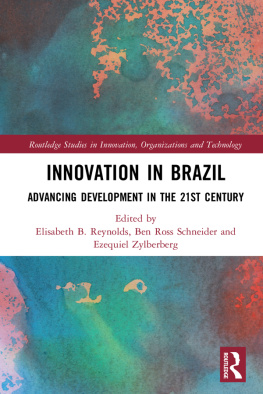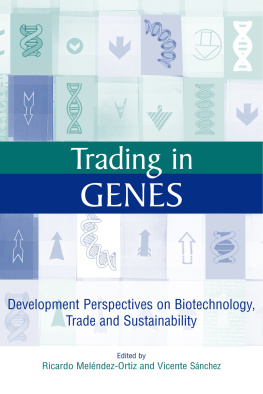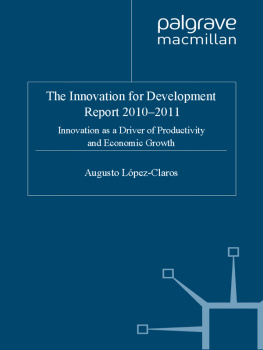Also by Banji Oyelaran-Oyeyinka and Padmashree Gehl Sampath
LATECOMER DEVELOPMENT: Innovation and Knowledge for Economic Catch-up
Also by Banji Oyelaran-Oyeyinka
UNEVEN PATHS OF DEVELOPMENT (with Rajah Rasiah)
INDUSTRIAL CLUSTERS AND INNOVATION SYSTEMS IN AFRICA:
Institutions, Markets and Policy (with Dorothy McCormick)
SMES AND NEW TECHNOLOGIES: Learning E-Business and Development
(with Kaushalesh Lal)
LEARNING TO COMPETE: Institutions, Technology and Enterprise in Africa
Also by Padmashree Gehl Sampath
UNHEALTHY DIVIDE: Local Capacity for Disease of the Poor
REGULATING BIOPROSPECTING: Institutions for Access and Drug Research
Notes
Preface
Oyelaran-Oyeyinka and Gehl-Sampath, P., Latecomer Development: States, Knowledge and Economic Catch-up, Routledge, September 2009; Gehl Sampath, P., Unhealthy Divide, Local Capacity for Disease of the Poor, 2010; Oyelaran-Oyeyinka, Banji and Rajah Rasiah (2009), Uneven Paths of Development: Innovation and Learning in Asia and Africa, Edward Elgar Publishing, United Kingdom.
1 Agricultural Biotechnology Innovation Capacity and Economic Development
The innovation system is defined as the set of organizations (e.g., firms, universities, and public laboratories) and their linkages through which innovation processes develop. For an in-depth analysis of innovation systems in developed countries, see OECD (2000).
In addition the author suggested five accelerators to get get agriculture moving. Much of Moshers five essentials presaged the key issues being put forward by current scholars of pro-poor agricultural growth. These accelerators are: (1) education for development; (2) production credit; (3) collective action by farmers; (4) improving and expanding agricultural land (through good husbandry and adoption of appropriate technologies), and (5) national planning for agricultural development with emphasis on enlightened public policies that support the agricultural sector, see Thompson et al. (2007).
The notion of scientific and technological convergence is discussed in the next section.
From 2005 till mid-2008, maize prices almost tripled, whereas wheat prices and rice prices increased by 127% and 170% respectively. At the same time, palm oil prices and soybean oil prices increased by 200% and 192% respectively.
The role of knowledge infrastructures and historical investments in universities and industrial and agricultural public research in Germany, Japan, the US, and recently in Taiwan Province of China and the Republic of Korea, have been well documented, see Mowery (2005).
Banji Oyelaran-Oyeyinka and Padmashree Gehl Sampath, Latecomer Development: Innovation and Knowledge for Economic Catch-Up (Routledge, 2009).
Edquist (2001) identifies nine broad similarities, namely: All SI approaches place innovation at the centre of activities; innovation processes are evolutionary in nature; all reject the concept of optimality and emphasize diversity and variety; they take innovation as an interactive learning process; they stress the interdependence between organizational actors, and they affirm that innovation generally occurs within an institutional context.
See Bell and Pavitt (1993) who make the distinction between technological capacity and capabilities; also the Hall and Dijkman (2006) articulation of innovation capacity in agriculture biotechnology.
R&D, however, it is defined, is not only an avenue for economic and social diversification (new products and processes) but also helps build scientific and technical competencies.
The Precautionary Principle was defined at the 1992 Rio Declaration on Environment and Development (UNCED, 1992) in a much broader way, and applies to a range of issues apart from agricultural biotechnology and GM crops. It was defined to be: Where there are threats of serious or irreversible environmental damage, lack of full scientific certainty shall not be used as a reason for postponing cost-effective measures to prevent environmental degradation.
See Edquist and Hommen (1998b) for a discussion of the subject.
This question naturally excludes the capacity of large multinational conglomerates operating in latecomer countries.
2 Sectoral Systems for Agricultural Biotechnology
This definition of an innovation system draws upon the work of Nelson and Winter (1982); Lundvall (1988); Freeman (1988), among others.
This and the next paragraph is based on Oyeyinka and Rasiah (2009).
See in this context, the analysis in Gehl Sampath, 2009.
Todays modern industrial societies evolved from a system of personal to impersonal exchange that is now build on complex institutions and highly knowledge specialized (North, 2005; Mokyr, 2002). As increased specialization occurred with the growth of markets, individuals exchanged increased specialized knowledge at the expense of less general knowledge(North, 2005, p. 122).
Amsden (1977) cites Allyn Youngs clarification of what an extent of market is.
She illustrates: Assume market 100 economic units in market A with an income of US$10000. Assume 1000 economic units in market B each with an income of US$1000 purchasing power in the two markets is equal, obviously a market of type A is a better candidate than a market type B for the absorption of non-essential goods with high unit costs, irrespective of how great increasing returns may be, and hence relatively high prices (Amsden, 1977, p. 218).
Biggs and Shah (2006).
David and Foray (2000) similarly identify four different communities, namely, the scientific community which is concerned with the capture, storage, analysis, and integration of experimental and observation data (p. 7). Another is a community of programmers involved with the open source movement. They create new knowledge and information with no profit motive. The third is the business community whose modus operandi is cooperative and organizational such as education and research consortia and networks. Another science-driven community is the health and medical profession whose practices are being increasingly science-driven.
and foreign direct investment (FDI), turnkey projects, technical consultancy, capital goods imports, and joint-venture agreements.
Technological capability derive from both internal and external knowledge and as such firms require an absorptive capacity defined by Cohen and Levinthal (1990) as the ability of a firm to recognize new information, assimilate it, and apply it for commercializing inventions. They argue that successful exploitation of basic scientific outputs require firms to continuously learn from external sources.
George et al. (2002) analyse 2457 alliances undertaken by 147 biotechnology firms, in order to arrive upon these findings. However, as the authors themselves note, it is not clear as to how much such collaborations influence (or enhance) the financial performance of the firms.
See Shartinger et al. (2002) and their references to different shades of the issue: academic research and biotechnology spin-offs from universities and PRIs (Fontes, 2004); transfer between university research and industry, (Lee and Win, 2004); on the overall impact of university research on industrial production (Jaffe, 1989; Anselin et al., 1997), and personnel mobility, (Bania et al., 1992; Almeida and Kogut, 1997).
Lubit (2001) identifies four categories of tacit knowledge, namely, (a) hard to pin down skills know-how, (b) mental models, which show us how the world is constructed, (c) ways of approaching problems, and (d) organizational routines. According to him, The word skill implies tacit knowledge which range from the ability to swing golf balls to the dexterity of handling cells in a biology lab, all which are hard to explain in words.
Next page




